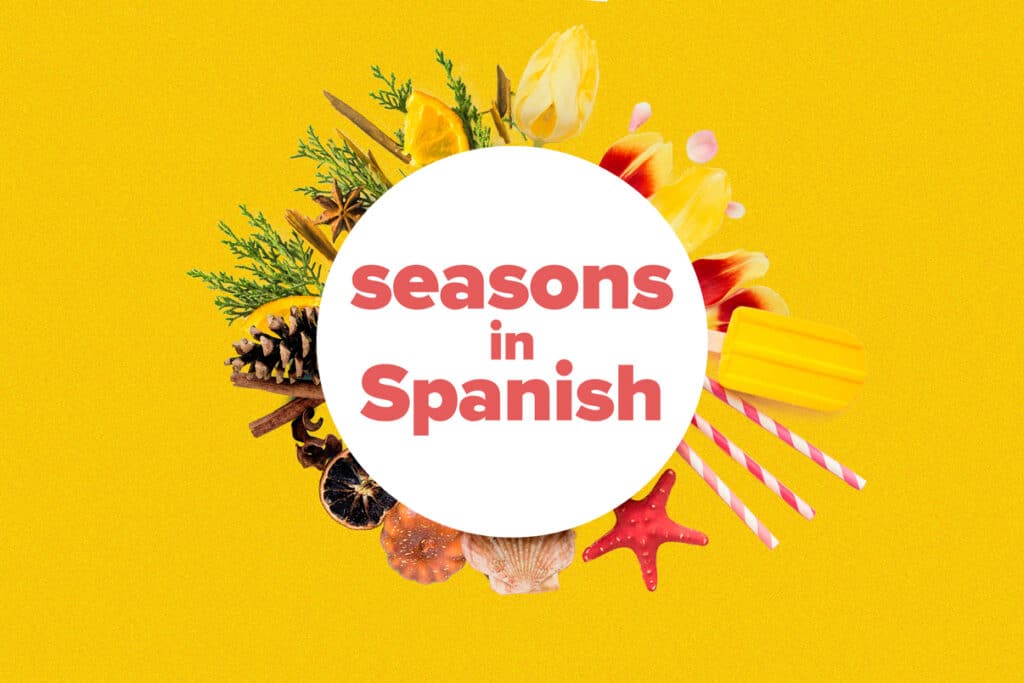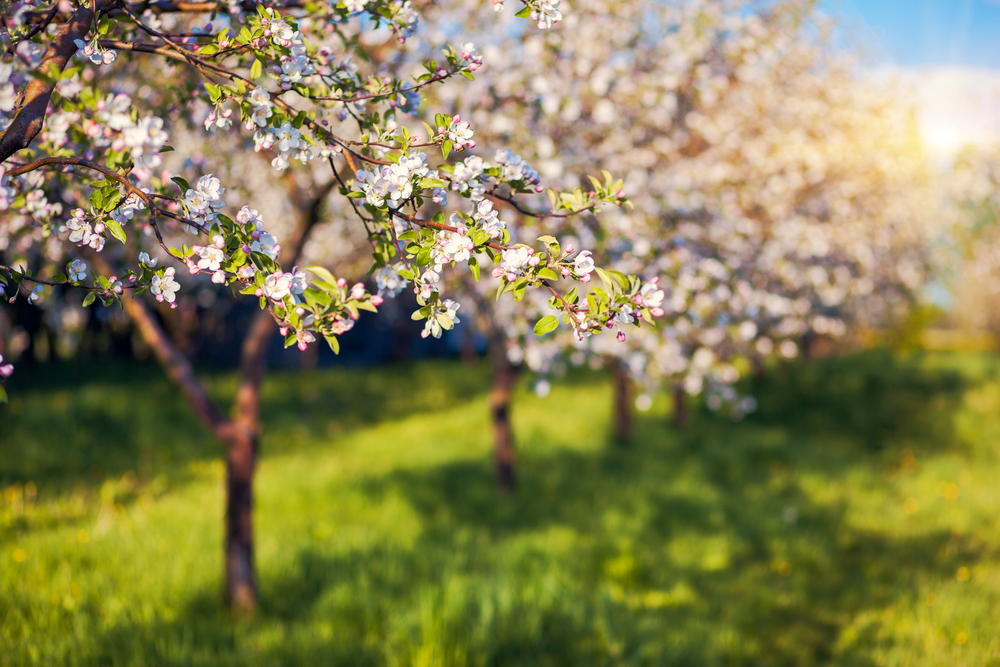
If you’re learning Spanish, the seasons are important words you’ll use when discussing everyday topics.
Seasons are especially relevant since Spanish-speaking countries span so much of the globe, including various climates and places in different hemispheres.
In this post, you’ll learn useful vocabulary for each season, how to talk about them with correct grammar and the difference between the words la estación and la temporada.
Contents
Download:
This blog post is available as a convenient and portable PDF that you
can take anywhere.
Click here to get a copy. (Download)
Las Estaciones — The “Seasons” in Spanish

First, you need to know how to say “seasons” in Spanish. It’s simple: estaciones.
Then we have the four estaciones, which are: la primavera (spring), el verano (summer), el otoño (autumn) and el invierno (winter).
It’s also important to note that some places close to the equator experience little seasonal variation, which is why we’ve added la estación lluviosa (rainy season) and la estación seca (dry season) to the end of this section.
La Primavera — Spring
Everyone loves spring, right? The world starts to wake up after its winter hibernation, leaves return to the trees and flowers start to bloom.
Let’s have a look at some of the ways you can describe this beautiful time of the year:
To learn more spring vocabulary, checkout our in-depth post here.
El Verano — Summer
Summer has got to be the most hyped season—and for good reason! Life just feels easier in summer, and everyone seems happier.
If you’re part of the majority who love summer, it’s worth knowing some of the major summer vocabulary in Spanish:
For more summer vocabulary, I highly recommend checking out our post about Spanish beach vocabulary here.
El Otoño — Autumn
Autumn is probably the most underrated season in my opinion.
It’s a welcome respite after the heat of summer, and (depending on where you live, of course) the colors in the world around you make autumn incredibly beautiful. It’s also the time of year it’s acceptable to start drinking pumpkin spice lattes again—yay!
Let’s have a look at some autumnal vocab:
In the mood to learn more autumn vocabulary? Check out our post on fall words next.
El Invierno — Winter
Lastly we have winter. Probably the most polarizing of the seasons, winter is undeniably as cozy as it is powerful.
Love it or hate it, it comes around every year and there’s no stopping it—so you may as well learn how to describe it in Spanish!
You can wrap up your winter Spanish studying with this post on more winter vocabulary.
La Estación Lluviosa — Rainy Season
Many of us aren’t familiar with rainy seasons, as they usually occur in countries located close to the equator.
We have however included la estación lluviosa because it’s experienced by several countries in Latin America!
La Estación Seca — Dry Season
In contrast to the rainy season, we have the dry season.
I don’t know about you, but I think I know which one I like the sound of more!
How to Talk About the Weather and Seasons in Spanish
Using Hay, Hace and Estar
In Spanish, there are three words you can use (and will hear) very often when describing the weather: hay, hace and estar.
Hay is the present simple form of the verb haber. It means “there is/are” and expresses something’s existence. When it comes to weather, you’ll hear expressions using hay after words like “clouds,” “sun” and “hail.” For example:
Hay nubes.
(It’s cloudy. Literally, “there are clouds.”)
Hay sol.
(It’s sunny. Literally, “there is sun.”)
Hay granizo.
(It’s hailing. Literally, “there is hail.”)
Hace is used to describe the sensation of the weather—or, how it feels. It translates literally to “it makes” and is commonly used with nouns like calor (heat) and frío (cold). These words are often translated into English as adjectives, which can make it confusing to understand. For example:
Hace frío.
(It’s cold. Literally, “it makes cold.”)
Hace calor.
(It’s hot. Literally, “it makes heat.”)
Hace fresco.
(It’s cool. Literally, “it makes cool.”)
Estar is used with more descriptive and specific adjectives that describe the state of the weather, not the sensation, just like hay. For example:
Está soleado.
(It’s sunny.)
Está húmedo.
(It’s humid.)
Está nublado.
(It’s cloudy.)
Describing weather in Spanish is a little more complicated than in English, where we simply use the verb “to be” to describe everything we see and feel. But the more you interact with Spanish—consuming content, talking with native speakers, etc.—you’ll find these simple grammar rules become second nature.
I also recommend trying an immersion program like FluentU, which lets you watch authentic Spanish videos to learn tricky words like hay, hacer and estar in context.
Each video comes with interactive subtitles, which means you can see how Spanish grammar is used by native speakers while also being able to click on words and structures you don’t know to get definitions.
Definite Article for Spanish Seasons
The definite article is used with the seasons more often than in English. This is true in both singular and plural forms. Note the definite articles el, la, los and las—all equivalent to English “the”—in these examples:
El otoño es mi estación favorita.
(Fall is my favorite season.)
El invierno ya viene.
(Winter is coming.)
Los veranos en el Mediterráneo son muy suaves.
(Summers in the Mediterranean are very mild.)
There are exceptions, specifically after the verb ser (to be) or the prepositions en or de (usually “in” or “of” in English).
Note these examples:
Es verano en España pero invierno en Argentina.
(It’s summer in Spain but winter in Argentina.)
Siempre tengo sueño en otoño.
(I’m always sleepy in the fall.)
Los días de invierno son muy cortos.
(Winter days are too short.)
Seasons in Adjective Form and Verb Form
In English, the nouns for seasons can become the following adjectives: spring, summery, autumnal/fall and wintery.
Spanish also has these adjective forms: primaveral (spring), veraniego (summery), otoñal (autumnal/fall) and invernal (wintery).
Like most adjectives in Spanish, they go after the noun.
Take a look at these sentences:
El tiempo primaveral es agradable.
(Spring weather is comfortable.)
El sol veraniego puede ser peligroso.
(The summery sun can be dangerous.)
Hay muchas tradiciones durante las fiestas otoñales.
(There are many traditions during the fall holidays.)
Este tiempo invernal es perfecto para Navidad.
(This wintery weather is perfect for Christmas.)
“Summer” and “winter” are also used as verbs in English, such as in the sentence, “My family always summers in the south of France.”
Similarly, verano and invierno have verb forms in Spanish: veranear and invernar.
They’re both -ar verbs and conjugated accordingly. Read through some examples:
Ella normalmente veranea junto a su familia.
(She usually summers together with her family.)
Desearía poder invernar en Cancún.
(I wish I could winter in Cancún.)
The Difference Between Estación and Temporada
The English word “season” has two distinct translations in Spanish.
If you’re talking about a part of the year like winter or summer, the word is la estación.
However, if you’re referring to a set time period during which an event takes place or something is available (like a sports season or a seasonal fruit), you use the word la temporada.
Look at these examples to get a better idea:
Un año tiene cuatro estaciones diferentes.
(A year has four different seasons.)
Las verduras son mejores de temporada.
(Vegetables are better in season.)
La temporada de caza empieza en octubre.
(Hunting season starts in October.)
Seasons in Spanish Practice Quiz
Without looking at the definitions or translations above, translate these sentences into Spanish to test how much your seasonal vocabulary has grown:
1. Season
2. Summer
3. Winter
4. Spring
5. Fall/autumn
6. It’s very cold today
7. It’s so sunny
8. It’s cloudy
9. It’s raining and hailing
10. She usually summers in Spain
Answers:
1. La estación / la temporada
2. El verano
3. El invierno
4. La primavera
5. El otoño
6. Hace mucho frío hoy
7. Hay mucho sol / está muy soleado
8. Hay nubes / está nublado
9. Está lloviendo y granizando
10. Ella normalmente veranea en España
Knowing how to talk about the seasons in Spanish opens up a whole world to you. Spanish-speaking countries aren’t just summer vacation spots anymore.
Now you can communicate all year round, from icy winters in the Andes mountains to flowery springs in Andalusia.
Whenever and wherever you decide to go, just take this vocabulary with you.
Download:
This blog post is available as a convenient and portable PDF that you
can take anywhere.
Click here to get a copy. (Download)





